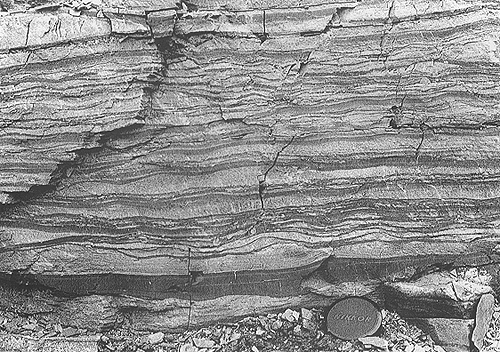
Heterolithic bedding: wavy and lenticular types
Plate 60

Heterolithic bedding: wavy and lenticular types
Plate 60
Heterolithic practically means made of two or three alternating lithotypes, the most common being sand and mud (sandstone and mudstone). Bed thickness can vary; the examples presented in this and the following plate are thin-bedded varieties, in both Ancient and Recent sediments.
The sandstone beds, belonging to the Triassic Servino Formation of southern Alps, are laminated and ripple-molded at the top. Their bases can also be undulated by sinking of sand and compaction of mud in troughs of underlying rippled beds. The stratification style has been called wavy bedding by students of tidal sediments,2 where it is commonly, though not exclusively, found. Bedding is also said to have a pinch-and-swell structure.
We see also, in the picture, that thinner sandstone beds loose their individuality laterally by leaving place to an alignment of discontinuous lenses. This means that tractive energy was available, but sand was not, at least in amounts sufficient to cover the whole bottom. That is a second stratification style, called lenticular bedding. Ripples separated by mud stripes are starved ripples.
Wavy bedding is also shown in plate 61 and in color photo 6.
Note 2: H.-E. Reineck and I. B. Singh. 1973. Sedimentary Environments. New York: Springer-Verlag. Back.